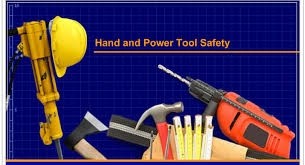Hand Tool Safety Rules List

Proper use of hand tools is essential in the preventing of injury. This includes maintaining a clean, well-lit workstation and wearing necessary safety accessories in addition to the correct use of the tools themselves. Using the right type of tool for the job is also key to preventing injury.
Work Area
Keeping your work area clean is the first step in hand tool safety. Refrain from leaving oily rags, paper and excessive dust in your work area as these are fire hazards and can damage your tools. Keep scrap materials in appropriate containers and ensure the area is kept dry. Wet work surfaces and floors can become electrical conductors as well as causing potential slips and falls. Make sure your work area is well-lit to avoid potential hazards. Keep your work area free from flammable objects and materials before using tools that can produce sparks. Knowing where the fire extinguishers, alarms and exit routes are located are additional precautions.
Personal Protective Equipment
Using protective equipment may also be necessary when working with hand tools. Wear safety glasses and shoes and additional items when needed including hard hats, gloves, respiratory and hearing protection, and welding masks. Discussing proper safety equipment and usage with your supervisor is also an option. Keep in mind that when operating power tools the noise can drown out other sounds such as a person yelling for help. Being mindful of your surroundings can help alleviate this problem. Wear the appropriate masks and discuss precautions with your supervisor before cutting certain materials such as plastic, which can release toxic fumes. Masks should be worn when using just about any hand tool, as dust is produced. Refrain from wearing jewelry or loose clothing, both of which can get tangled in power tools. Hand jewelry can work as an electricity conductor. Keep long hair tied back in braids, a ponytail or a bun. Neckties can also get caught in machinery.
Using The Tools
Always use the correct tool for the job you are performing. Forcing smaller tools to do large jobs can cause a strain on the tool, which can result in the tool breaking -- which can cause injury. Do not use tools if you are unfamiliar with how they work -- and get correct instruction from your supervisor or tool manufacturer before using them. Read tools' manuals for correct use and inspect tools before use for any breakage, cracks and the proper alignment of moving parts. Always disconnect the power source of the tool before cleaning or fixing it, or changing blades or parts. Keep tools in a secure area, away from work-table edges where they can fall and cause injury. Never use tools when you are tired, as this can result in a reduced attention span. Hold tools correctly by their insulated grasping surfaces and ensure the material you are working on is secure. Do not work in an awkward position, which can lead to less-than-optimal handling of the tool or piece being worked on.
Work Area
Keeping your work area clean is the first step in hand tool safety. Refrain from leaving oily rags, paper and excessive dust in your work area as these are fire hazards and can damage your tools. Keep scrap materials in appropriate containers and ensure the area is kept dry. Wet work surfaces and floors can become electrical conductors as well as causing potential slips and falls. Make sure your work area is well-lit to avoid potential hazards. Keep your work area free from flammable objects and materials before using tools that can produce sparks. Knowing where the fire extinguishers, alarms and exit routes are located are additional precautions.
Personal Protective Equipment
Using protective equipment may also be necessary when working with hand tools. Wear safety glasses and shoes and additional items when needed including hard hats, gloves, respiratory and hearing protection, and welding masks. Discussing proper safety equipment and usage with your supervisor is also an option. Keep in mind that when operating power tools the noise can drown out other sounds such as a person yelling for help. Being mindful of your surroundings can help alleviate this problem. Wear the appropriate masks and discuss precautions with your supervisor before cutting certain materials such as plastic, which can release toxic fumes. Masks should be worn when using just about any hand tool, as dust is produced. Refrain from wearing jewelry or loose clothing, both of which can get tangled in power tools. Hand jewelry can work as an electricity conductor. Keep long hair tied back in braids, a ponytail or a bun. Neckties can also get caught in machinery.
Using The Tools
Always use the correct tool for the job you are performing. Forcing smaller tools to do large jobs can cause a strain on the tool, which can result in the tool breaking -- which can cause injury. Do not use tools if you are unfamiliar with how they work -- and get correct instruction from your supervisor or tool manufacturer before using them. Read tools' manuals for correct use and inspect tools before use for any breakage, cracks and the proper alignment of moving parts. Always disconnect the power source of the tool before cleaning or fixing it, or changing blades or parts. Keep tools in a secure area, away from work-table edges where they can fall and cause injury. Never use tools when you are tired, as this can result in a reduced attention span. Hold tools correctly by their insulated grasping surfaces and ensure the material you are working on is secure. Do not work in an awkward position, which can lead to less-than-optimal handling of the tool or piece being worked on.
- sm012779784a52e783e26e558180959229.jpg